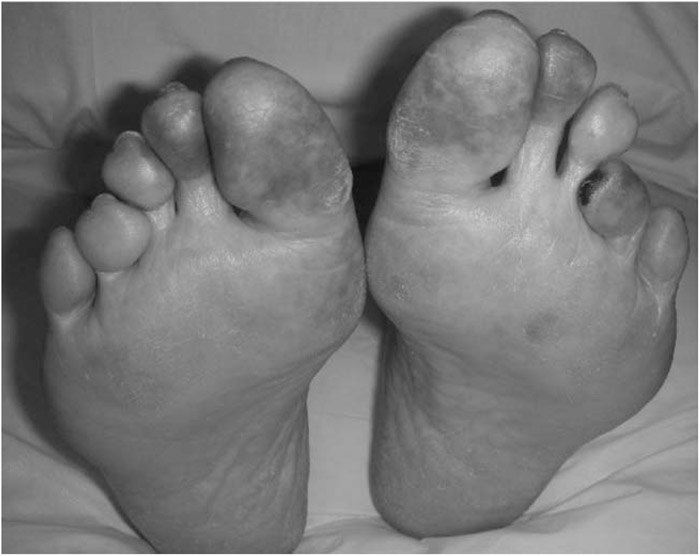Case Presentation:
A 71‐year‐old woman with hypertension presented from an outside hospital for a second opinion. Five months prior to admission she discovered that she had factor V Leiden and developed a deep vein thrombosis of the lower extremity 2 months later. She was started on Love‐nox and Coumadin and developed a blue toe. One month prior to admission, the rest of her toes bilaterally became dusky, purple, and painful with dry gangrene and livedo reticularis. She was found to be in acute renal failure with a creatinine of 2.4 (baseline of 0.6) and was started on heparin. Her complements were normal, but she had eosinophilia. The vascular surgeons performed an aortogram that revealed an abdominal aortic aneurysm and right popliteal artery stenosis, which was angioplastied after a second aortogram. The pain and bluish toes persisted, so she was transferred to our hospital for further evaluation. She underwent an extensive workup for vasculitis and was empirically started on steroids given her erythrocyte sedimentation rate of 91, C‐reactive protein of 87, renal failure, and diffuse vascular involvement. Her urine sediment and vasculitis workup were otherwise unremarkable. There was debate over whether to obtain a biopsy (renal vs. skin) to confirm the diagnosis and whether to continue anticoagulation. Given her recent aortogram and angioplasty, acute renal failure, and blue toe syndrome, we believed this was most consistent with cholesterol emboli. We elected to defer the biopsy and stop the steroids. We continued her anticoagulation given her factor V Leiden and recent deep vein thrombosis. Treatment included prevention of further emboli including a high‐dose statin and avoiding further instrumentation.
Discussion:
Cholesterol embolization syndrome occurs in up to 1% of patients undergoing angiography. Cholesterol emboli showers from atherosclerosis and can cause diffuse end‐organ damage. It is important to determine the source and confirm the diagnosis. Treatment goals are twofold: supportive care for end‐organ damage and secondary prophylaxis against another episode. There is controversy over anticoagulation given 2 theories: (1) the fibrin lining the aorta and larger vessels can be stripped releasing the plaque and cholesterol emboli, and (2) local bleeding can cause plaque rupture and further showering of cholesterol emboli. Anticoagulation and diagnosis were highly debated among the various services, and eventually the decision was made to stop the steroids, avoid a biopsy, and continue anticoagulation given the factor V Leiden and recent clot.
Conclusions:
Hospitalists are caring for many patients who undergo cardiac and vascular instrumentation and need to be aware of the potential complications. In addition, hospitalists are challenged with difficult decisions, especially when consultants have differing opinions.
Disclosures:
S. J. Wang ‐ none

